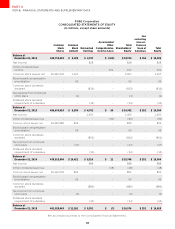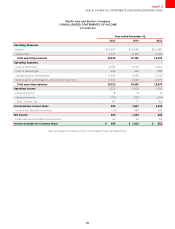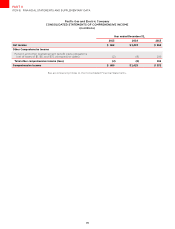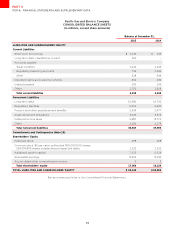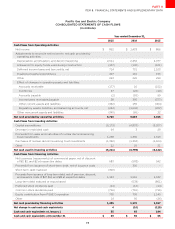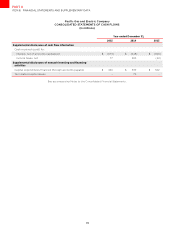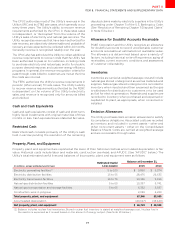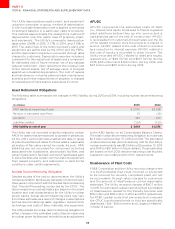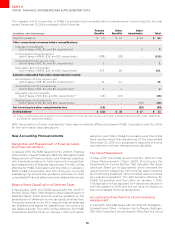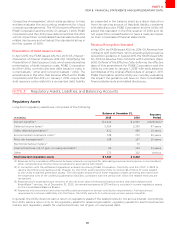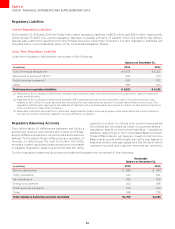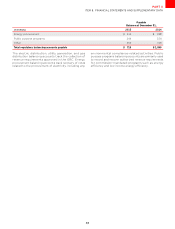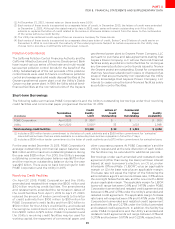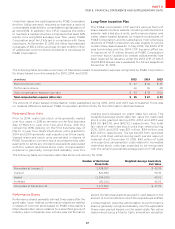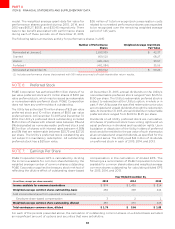PG&E 2015 Annual Report Download - page 86
Download and view the complete annual report
Please find page 86 of the 2015 PG&E annual report below. You can navigate through the pages in the report by either clicking on the pages listed below, or by using the keyword search tool below to find specific information within the annual report.
78
PART II
ITEM 8.FINANCIAL STATEMENTS AND SUPPLEMENTARY DATA
The Utility depreciates property, plant, and equipment
using the composite, or group, method of depreciation,
in which a single depreciation rate is applied to the gross
investment balance in a particular class of property.
This method approximates the straight line method of
depreciation over the useful lives of property, plant,
and equipment. The Utility’s composite depreciation
rates were 3.80% in 2015, 3.77% in 2014, and 3.51% in
2013. The useful lives of the Utility’s property, plant, and
equipment are authorized by the CPUC and the FERC,
and the depreciation expense is recovered through rates
charged to customers. Depreciation expense includes a
component for the original cost of assets and a component
for estimated cost of future removal, net of any salvage
value at retirement. Upon retirement, the original cost
of the retired assets, net of salvage value, is charged
against accumulated depreciation. The cost of repairs
and maintenance, including planned major maintenance
activities and minor replacements of property, is charged
to operating and maintenance expense as incurred.
AFUDC
AFUDC represents the estimated costs of debt
(i.e.,interest) and equity funds used to finance regulated
plant additions before they go into service and is
capitalized as part of the cost of construction. AFUDC
is recoverable from customers through rates over the life
of the related property once the property is placed in
service. AFUDC related to the cost of debt is recorded
as a reduction to interest expense. AFUDC related to
the cost of equity is recorded in other income. The
Utility recorded AFUDC related to debt and equity,
respectively, of $48 million and $107 million during
2015, $45 million and $100 million during 2014, and
$47million and $101million during 2013.
Asset Retirement Obligations
The following table summarizes the changes in ARO liability during 2015 and 2014, including nuclear decommissioning
obligations:
(inmillions)
AROliabilityatbeginningofyear
Revisioninestimatedcashflows ()
Accretion
Liabilitiessettled () ()
AROliabilityatendofyear
The Utility has not recorded a liability related to certain
ARO’s for assets that are expected to operate in perpetuity.
As the Utility cannot estimate a settlement date or range
of potential settlement dates for these assets, reasonable
estimates of fair value cannot be made. As such, ARO
liabilities are not recorded for retirement activities
associated with substations, photovoltaic facilities, and
certain hydroelectric facilities; removal of lead-based paint
in some facilities and certain communications equipment
from leased property; and restoration or land to the
conditions under certain agreements.
Nuclear Decommissioning Obligation
Detailed studies of the cost to decommission the Utility’s
nuclear generation facilities are generally conducted every
three years in conjunction with the Nuclear Decommissioning
Cost Triennial Proceeding conducted by the CPUC. The
decommissioning cost estimates are based on the plant
location and cost characteristics for the Utility’s nuclear
power plants. Actual decommissioning costs may vary
from these estimates as a result of changes in assumptions
such as decommissioning dates; regulatory requirements;
technology; and costs of labor, materials, and equipment.
The Utility adjusts its nuclear decommissioning obligation to
reflect changes in the estimated costs of decommissioning
its nuclear power facilities and records this as an adjustment
to the ARO liability on its Consolidated Balance Sheets.
The total nuclear decommissioning obligation accrued was
$2.5 billion at December 31, 2015 and 2014. The estimated
undiscounted nuclear decommissioning cost for the Utility’s
nuclear power plants was $3.5 billion at December 31, 2015
and 2014 (or $6.1 billion in future dollars). These estimates
are based on the 2012 decommissioning cost studies,
prepared in accordance with CPUC requirements.
Disallowance of Plant Costs
PG&E Corporation and the Utility record a charge when
it is both probable that costs incurred or projected
to be incurred for recently completed plant will not
be recoverable through rates charged to customers
and the amount of disallowance can be reasonably
estimated. The Utility recorded charges of $407 million
in 2015 for estimated capital spending that is probable
of disallowance related to the Penalty Decision and
$116million and $196 million in 2014 and 2013, respectively,
for PSEP capital costs that are expected to exceed
the CPUC’s authorized levels or that are specifically
disallowed. (See “Enforcement and Litigation Matters”
in Note 13 below).


